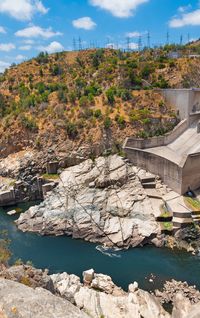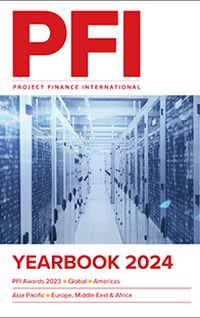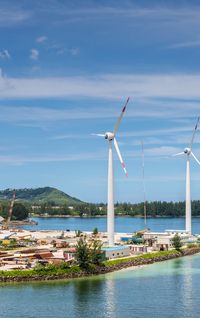NEOM Green Hydrogen holds the honour of being the first green hydrogen project to raise billions by way of project financing after it reached financial close earlier this year. Carina Radford, Mark Andrews and Jake Seal of White & Case LLP explore the significance of the transaction at a critical point in the story of the energy transition.
Even by the standards of first-of-their-kind transactions, the NEOM Green Hydrogen Project is remarkable in its vision and scale and has made its entrance to the market as both the first commercial-scale green hydrogen project to achieve financial close and the largest greenfield renewables project in history. As the only bankable precedent for stakeholders in this space to look to in the near-term, the project represents an impressive achievement for NEOM Green Hydrogen Company (NGHC) and its shareholders – ACWA Power, Air Products and NEOM – which jointly own the project company.
With a total investment value of US$8.4bn, the project is due to come online by the end of 2026 with an expected initial production capacity of up to 600 tonnes of hydrogen each day. NEOM Green Hydrogen Company will be the world’s largest green hydrogen producer, with the project making equivalent savings in CO2 emissions of up to 5m tonnes each year. That is equal to the annual electricity consumption of 1m homes1, demonstrating the real-world impact that can be seen in the advent of low carbon giga-scale projects.
The scale of the project is borne out by expected market demand, with the clean hydrogen market forecast to reach an annual value of US$1.4trn by 2050,2 and the sheer ambition of Saudi Arabia’s Vision 2030 strategy. NGHC is currently building the world's largest plant to produce green hydrogen at scale in Oxagon, an advanced and clean industrial city strategically located on the Red Sea in Saudi Arabia's region of NEOM. The project is the first recipient of an industrial operating licence from Saudi Arabia’s Ministry of Industry and Mineral Resources (granted in January 2023).
The project
The market response to the transaction was emphatic and the project company comfortably secured US$6.1bn of project financing debt, comprising both senior and mezzanine tranches. The financing was provided by 23 financial institutions made up of a mix of international, regional and local banks, export credit cover (ECA) cover from Euler Hermes, as well as substantial commitments from the Saudi Industrial Development Fund (SIDF) and the Kingdom’s National Development Fund on behalf of the National Infrastructure Fund (NIF). Importantly, it is also one of the largest project financings put in place that has been certified as green loan-compliant. The transaction achieved financial close in May 2023, just a matter of months after the core financing agreements had been signed.
The somewhat elusive nature of the NEOM Green Hydrogen Project, in terms of its sectoral classification and the pick-and-mix technical component characteristics, is a marked sign of the new wave of energy transition projects. Its financiers were asked to be nimble in how they brought together various reference points to develop their credit assessment.
The lump-sum turnkey EPC with Air Products as contractor, at a value of about US$6.7bn, held clear similarities to the equivalent contractual structure of large-scale IPPs, with the wind and solar farms and associated BESS soothingly recognisable elements as mature and proven technologies, regardless of their scale. Moving through the project structure, although the electrolyser market remains under development as technology is rapidly changing, the supplier, tk nucera, is a market leader with a robust strategy for its delivery programme and commitment to continued investment in maintenance and upgrades, a key element in derisking the project’s first-mover status.
Similarly, Air Products has a proven track record for delivering mega projects in the Kingdom, having recently completed the world-scale air separation project in Jazan. The remaining components, such as the storage and port facilities, were not of themselves novel or complex, although the integration of the renewable power elements, the private transmission grid, the green hydrogen product and the ammonia facilities at this scale makes this a very innovative project.
The early lock-in of the mega electrolyser supply was of crucial importance in facilitating the lenders’ credit assessment and helping to mitigate the challenges typically presented by the "first come, first served" approach to electrolyser supply that has been seen in recent years as global manufacturing capacity ramps up in the face of exponential demand. The project also, of course, benefits from its strategic and political importance to the Kingdom, with its well-established track record as the home of mega-project financings, with the wider NEOM project’s founded on the principle of sustainability and being the cornerstone of Saudi Arabia’s Vision 2030 strategy.
The NEOM Green Hydrogen Project is very much a symbol of the strength of Saudi Arabia’s commitment to achieving its climate change goals, which under the Saudi Green Initiative include a target for renewable energy sources to be generating at least 50% of its power by 2030. Indeed, the region is well-positioned to take advantage of the influx of capital for future green mega-projects both with its abundant levels of sunlight and wind and its location affording easy access to both European and Asian markets.
Underpinning all of this was a 30-year exclusive offtake agreement with Air Products, which, of course, is an established market-leader in the hydrogen economy and a US listed company with a credit rating of A (S&P). That Air Products is absorbing all of the downstream risk on the project was critical in smoothening the bankability analysis of the financiers and is testament to the shareholders’ collective confidence in the long-term hydrogen market.
Air Products, already the world’s largest hydrogen producer, will benefit from the growing recognition from governments around the globe that green hydrogen has the potential to prove revolutionary in decarbonising the heavily-polluting transportation sector (estimated to be responsible for 29% of greenhouse gas emissions)3. Air Products therefore saw the potential in an offtake strategy focusing on securing long-term agreements with local authorities to supply green hydrogen to fleets of new green buses that are expected to enter service over the next few years. The project is estimated to produce enough green hydrogen to power 20,000 buses annually.
At first glance, therefore, the project’s constituent parts echoed known elements that had populated positive credit committee papers for years, but in the process of bringing them together in a new way, at a never-before-seen scale and in the context of the Kingdom’s Vision 2030, a new picture and type of project was being formed. Most significant was the fact that the project financing was being executed in the context of a green hydrogen market that was just beginning to write its own story, and in respect of which commentators diverged on the tempo and manner of that development.
On that basis, a strong vision of the accelerated demand for green hydrogen was the core foundation of the project and the timing of its implementation to take advantage of first-mover status. The shareholders firmly considered this ground-breaking project to be “shaping the future of energy” in their pursuit of a decarbonised service model for the “global mobility and industrial markets”.4
Here, therefore, was a project daring to ask financiers to believe in the long-term vision of a new market, while at the same time presenting a new technical project configuration at a record scale. The project was clearly no neat fit and so financiers were asked to lean into their knowledge and comfort with other comparable sectors (including power, oil and gas, industrial downstream and shipping sectors), and in that way develop a new expertise for this and similar emerging energy transition projects.
A new dawn
The NEOM Green Hydrogen Project did not offer neat "tick-boxes" of risk and mitigation that allowed its project financiers to just rely on single-sector, single-industry, long-standing project finance risk allocation principles. Instead, the shareholders, NGHC and the financiers had to create a new template for risk assessment and adopt a different approach to market risk, all founded on the shared belief in the necessary success of projects such as these to support the energy transition.
The result is a ground-breaking template for the future – one that has thrown down a marker for mega-scale green hydrogen projects coming down the pipeline anywhere in the world. The fact that the project attracted such a large and wide group of lenders (and was, indeed, well oversubscribed) sends a signal loud and clear to others across the energy transition space that the project finance market is ready to embrace, and invest in, the pace of change that the energy transition is bringing about.
Footnotes
1 - US Environmental Protection Agency - https://www.epa.gov/energy/greenhouse-gas-equivalencies-calculator#results.
2 - Deloitte – Green hydrogen: Energizing the path to net zero (2023).
3 - US Office of Energy Efficiency & Renewable Energy, Hydrogen’s Role in Transportation | Department of Energy
4 - Seifi Ghesimi, Chairman, President and Chief Executive Officer, Air Products at https://www.nghc.com/nghc-full-financial-close/.
![]()
To see the digital version of this report, please click here.
To purchase printed copies or a PDF of this report, please email leonie.welss@lseg.com














